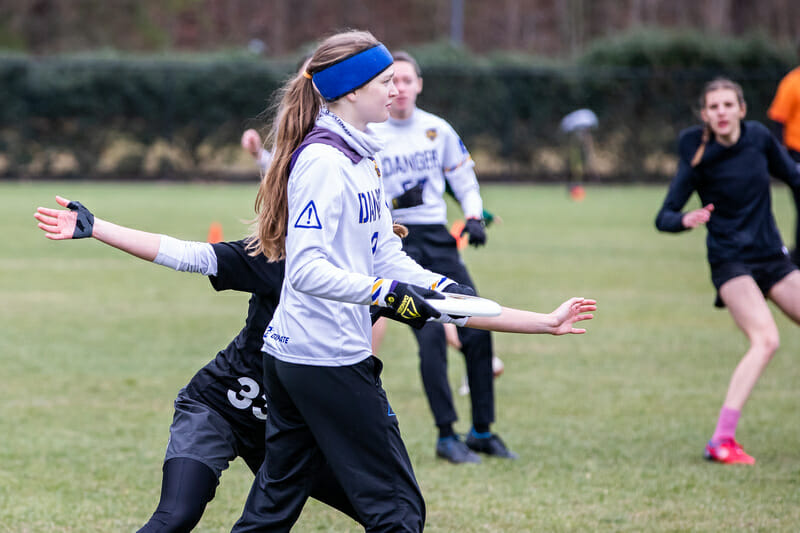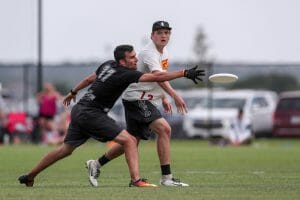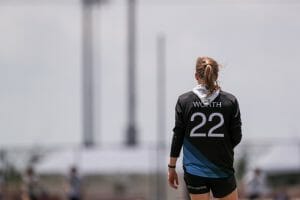What the 2022 Spring season means to the select few who are getting the unusual opportunity to get a second chance to play college ultimate.
March 30, 2022 by Graham Gerhart in Profile with 0 comments

Our coverage of the 2022 college season is presented by Spin Ultimate. You can get 15% off all college uniforms and swag right now at Spin Ultimate!
It was almost 15 years ago when Washington’s Manny Eckert was first introduced to ultimate. By his own admission, ultimate was the only sport offered at his tiny Seattle private school, but he was already active in many other ways, including his other childhood passion: the circus. For some reason, the sport gripped him in the same way it has for so many others, and in 2022, Eckert has been given a rare chance to do something unprecedented, offered to only a select few. For the first time since USAU started running the college division and restricting eligibility, they’re opening up the spring season to seventh year students, allowing them one last opportunity to compete for their university program.
The number of those returning for their seventh year — affectionately referred to by some as ‘college masters players’, a term coined by Mags Colvett — are few. While they might be an endangered species, these players are avatars for many who remember their college careers fondly, and even would wish for nothing more than another chance to play a final few tournaments with the team that solidified their love of the sport.
And yet…
Starting a seventh year with a college program means something very different with a college team than running it back with tenured veteran status on a club team. While there is an expectation of longevity at the club level, one of the joys of college ultimate is that it’s a finite resource. The impermanence of college ultimate pushes players far harder than they would have thought possible. With only five years of eligibility, the ticking of the clock sounds far louder for college players than it ever could for those competing at higher levels.
Extending the time frame for certain players has not come without some pushback. There are many who point to juniors or seniors who also had seasons of their competitive college career stolen from them that will still not be handed the reins of their team despite having endured the same cancellations as their seventh year brethren.
Beyond all of that, a seventh year player is in a very different frame of mind from the college freshmen and sophomores that they’ll be competing with. The difference in priorities and lifestyle between an 18-year old undergrad and a 24-year old postgraduate student is a wide chasm to cross. To add to this argument, there are those who have noted that the inclusion of a seventh year player takes away touches and reps from these younger players that will eventually be the backbone of their program, and their development is on the line.
That’s not to say that these questions and concerns have gone unheeded by the seventh year players. These athletes have gone through the same thought process as everyone, but due to a plethora of reasons, the reward of returning in the spring far outweighs the risks that go with it. Despite the weight of expectations and uncertainty this season may have, it’s the resilience of these players that has brought them back for one last ride.
When USAU first announced that it was going to allow sixth and seventh year players to return in 2022, it was right after of their cancellation of the 2021 spring season. For many, that cancellation announcement in 2021 was the end of the college ultimate dream. These players had invested so much emotional energy into the 2020 season, only for it to fall apart, and then rekindling that flame to prepare for 2021, only for it to be taken away, too. Even after USAU offered the fall 2021 Series as a lifeline, the pain was already there. To make matters worse, there were many schools that had complications preventing these students from competing in the fall Series.

“I was focused on what the fall 2021 College Series was going to look like for our team,” said Minnesota’s Cole Jurek. “However, shortly after USAU’s press release, we got the news from our sports club office that Grey Duck would not be able to attend fall college Nationals because the tournament was completely eclipsed by the university’s official final exams week, and that it was university policy that no school-sponsored travel be permitted during that time. That policy had essentially put an end to my college frisbee career, and I didn’t even consider coming back to use my extra year of eligibility for a long time after that.”
It wasn’t just the students excluded from the fall Series that felt the burnout from 2021. While USAU had permitted students to return, there wasn’t a lot of clarity around it, and many weren’t sure of eligibility and whether their schools would allow it. “I had a moment in the fall of 2021 when I was doing roster stuff for USAU and had a panic moment when reading the eligibility guidelines,” said Pitt’s Annelise Peters. “I psyched myself out and didn’t think I’d get to play in the spring and went home and cried.”
The funny thing about athletes, though, is how willing we are to get up from our lowest moments for one more chance to step on the field again. While many were willing to hang up their cleats and college jerseys after all the heartbreak and discouragement that 2020 and 2021 brought, it didn’t take much convincing for others. “I emailed Ben [Feng] and asked if I’d still be eligible and when he said yes it was just another moment of incredible disbelief,” said Peters. “How did I get so lucky?”
2022 also was an olive branch for those that had been dealing with another restraint in previous years: season ending injuries. Anne Worth, UNC’s Callahan winner from 2020, had spent most of the past year sidelined from an ACL injury that prevented her from competing at both club Nationals in the summer, and D-I Nationals in the fall. For her, this upcoming season is a redemption point for all that she missed from North Carolina’s successful 2021. “I’ve had my sights set on spring college Nationals as a reasonable return-to-play timeline, and because I missed out on fall Nationals, the opportunity to play in the spring is really exciting.”
Even those that were initially skeptical about returning for the 2022 season started to feel drawn back once the momentum built up. “Trevor Graham and I, who had played four years on Grey Duck together, started mulling over the idea of returning… when we, as members of Sub Zero, scrimmaged Grey Duck at an indoor tournament,” said Jurek. “Seeing the team play again both reopened some old wounds and emotions regarding the tragic way our college careers had ended, as well as revitalized the passion we had once had for the program. We realized how fulfilling it would be to be able to finish our college careers the way they were meant to be, and that the opportunity for the work we had put into the program over the last five years to come to fruition was right there in front of us.”
Across the board, the motivation for returning is much the same as what Jurek expressed, with the addition of some unrestrained enthusiasm. Many players remark on their appreciation for being able to return, and note that they aren’t taking it for granted. The allure of college ultimate is too tantalizing to avoid, and the camaraderie is unmatched. Of course, for some, there’s one more level of motivation beyond excitement.
“My motivation for playing in the spring is to win a championship,” said Eckert, and he was far from alone.

“I want to be part of the squad that wins back-to-back college championships,” notes Worth. “Winning that title was so out of the realm of possibility my freshman year when we didn’t even make Nationals. The idea of even being in the conversation to win it in my final season is incredible.”
While medals might be on their mind, most college seventh year players are quick to admit that there is a substantial difference in lifestyle and expectations between them and incoming freshmen and sophomores, which affects their role in 2022, both on and off the field. As Worth highlighted, a team can change drastically between one’s freshman year and seventh year, and it’s safe to say almost every college program is still going through some form of a rebuild thanks to the pandemic. Without on-campus learning and limited access to fields or organized practices for much of the last two full years, most teams came into this spring with a long way to go toward building up their freshmen and sophomore players to be ready to compete. This can often stand at odds with the seventh year students, many of whom are returning with the expectation of competing at the highest level they can.
What this dichotomy looks like differs from school to school, but the role of the seventh years is often quite similar. They might not have the same connection to the team that they once did, but they can still provide guidance and help with player development, alleviating some of the pressure on the coaching staff which have a larger burden this season than in years past. Most of the college masters players see themselves in an unofficial mentorship or coaching role, although many are quick to heap praises onto the current coaches and captains of their college program, who’re doing the hard work of rallying the team in a pandemic, while the seventh years pursue postgraduate degrees or move on to the working world.
As for their on-field roles, seventh years find themselves in a difficult position. Many are too skilled to have their position ceded to a younger player, but also acknowledge that they’re no longer the future of their team, and there’s the ethereal space that they fill between being in the present or the past of their team’s dynamic. In multiple instances, the players who are not in a postgraduate program admit that they will likely not make all of the team’s practices, and rely on their experience to help provide chemistry with the team at tournaments. “I think acknowledging and embracing the weirdness of the situation just allows you to have fun with it,” noted Jurek.
For Peters and others who are pursuing their postgraduate degrees, it’s the help that they can provide in practice that they really see affecting their dynamic with their younger teammates. “At this point, I’m a person that they can ask questions to, match up against, and hopefully challenge them to get better every day at practice.”
Regardless of whether they’re able to attend every practice or not, all seventh years admit that the interplay between them and their teammates has changed drastically from when they were a young player on the team. They’re not as strongly involved in the team’s social events or inside jokes. The distance in age is distinct, as is their maturity and goals for the year. In almost every case, there’s a wistfulness from the seventh years when discussing this gap between them and the rest of the team, but also a reflective acknowledgement of their situation. “I’m definitely less connected with the team socially than I was in college,” admitted Worth. “But I think that’s a good boundary to have because of the huge age difference.”
By reflecting on the change in team dynamics, it naturally leads to questions about team culture, too. The college masters have a unique experience to be able to see a full generation come and go in their program, and the difference that creates in the culture of a program. So often, a team is defined by the attitude and actions of the juniors and seniors within their program. These players may influence the next generation, but it’s inevitable that each new crop of upperclassmen bring their own spin to the culture itself. The remaining seventh years get a unique opportunity to witness this change, while still being a part of it in some capacity. While it is jarring for some, others embrace the changes for what they are. “During my freshman year, the team’s culture was defined mostly by the weird snapchat videos a then 24-year-old Ben Jagt would send me,” said Jurek. “Now that I’m 24, I’m hoping I can be that guy.”
Aside from helping shape the team’s culture, many players are appreciative of how much their teams have grown at a communal level. “There is much more unity and communication among the team than there was when I was a freshman,” said Eckert. “It feels that, off the field, social circles are larger, and on the field, there is more trust than ever before.”
This has been true for most seventh years interviewed, but some took it a step further. Worth’s role may have been minimized during the last year, but she was very clear about how the development of UNC’s culture was a community-driven initiative. “I think the most significant change has been our relationship with the men’s team. At this point, the two teams really operate as a unit. Both of us want the other to succeed, so we’re just constantly sharing resources and building each other up,” said the 2020 Callahan winner. “This creates this wonderful, selfless culture around UNC ultimate. It wasn’t always that way, and I try to remind new leaders on the team that culture can change quickly.”
When it comes down to it, many college teams have seen that drastic culture change thanks to the pandemic and how that has affected team bonding. For the college masters players, most are in agreement that it’s not their place to dictate culture. But as veterans, they can’t help but be a part of setting the tone in some capacity, both on and off the field.
Each of the seventh years took care to point out the difficulty that they had to go through to even compete this season. These struggles ranged from injuries, to institutional challenges, to on-field heartbreak, and even work-life balance. Playing a seventh year is not as breezy a concept as it may seem, and it likely is the reason more players did not take USAU up on the opportunity to do so. The first few years of college are a unique situation where the amount of free time and freedom from responsibilities intersects perfectly to allow for ultimate to take a unique place in an athlete’s priority list. This doesn’t translate well to seventh years.
And yet…
We’re about to wrap up a college regular season that has been filled with unpredictability, from the structure of bid-earning to the results on the field. The early season news — players returning to clubs, joining new ones with their extra eligibility, event cancellations, team dropouts — has been challenging to keep track of.
Despite all of this, college masters players want to compete. The draw of that final year, that final shot at Nationals glory, is enough to bring them back, difficulties be damned. You don’t make it to your seventh year without a will to compete, and what’s competition without a little adversity?
“Playing frisbee throughout my law school career has been the most challenging thing I’ve ever done and has broken me more than once,” said Peters. “I wouldn’t trade it for anything in the world.”